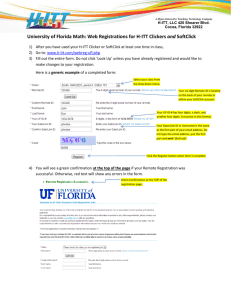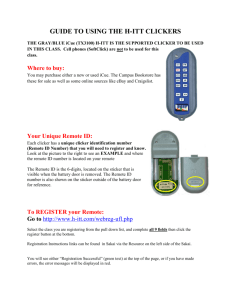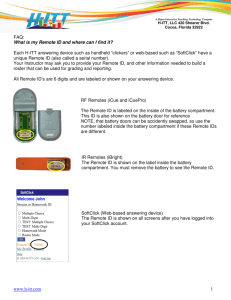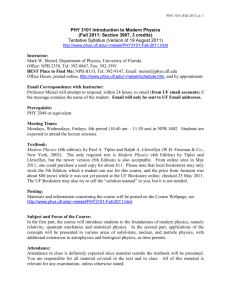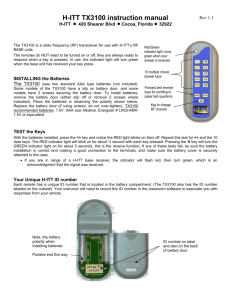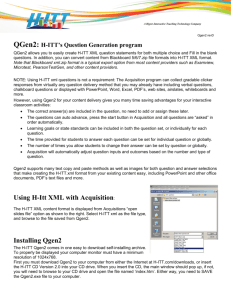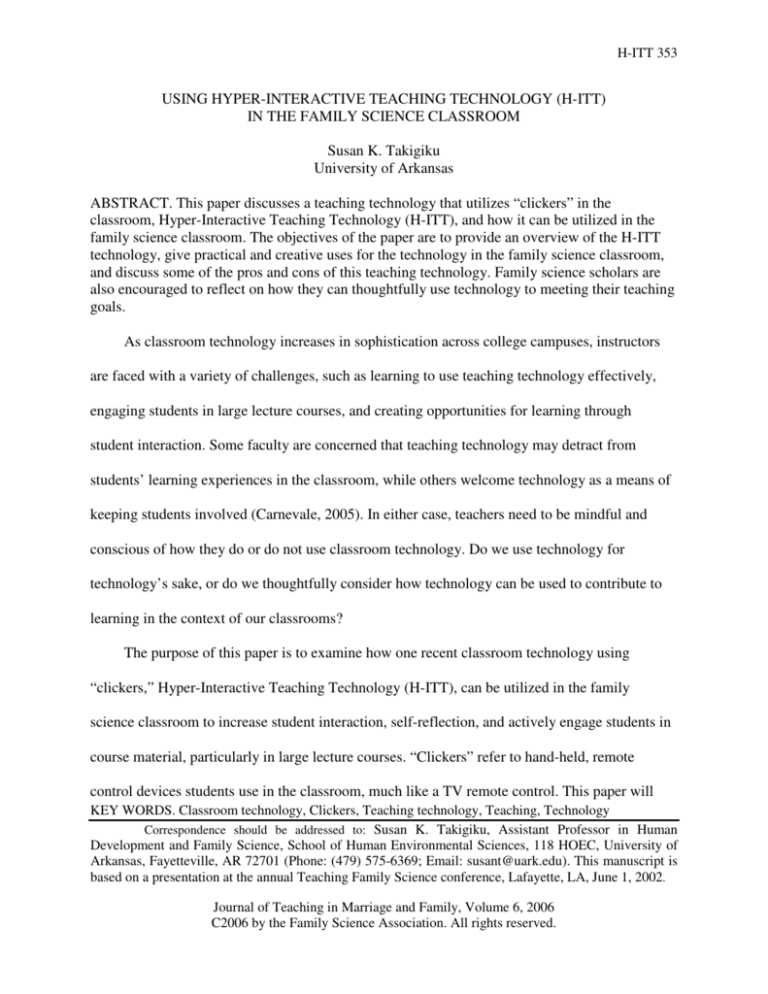
H-ITT 353
USING HYPER-INTERACTIVE TEACHING TECHNOLOGY (H-ITT)
IN THE FAMILY SCIENCE CLASSROOM
Susan K. Takigiku
University of Arkansas
ABSTRACT. This paper discusses a teaching technology that utilizes “clickers” in the
classroom, Hyper-Interactive Teaching Technology (H-ITT), and how it can be utilized in the
family science classroom. The objectives of the paper are to provide an overview of the H-ITT
technology, give practical and creative uses for the technology in the family science classroom,
and discuss some of the pros and cons of this teaching technology. Family science scholars are
also encouraged to reflect on how they can thoughtfully use technology to meeting their teaching
goals.
As classroom technology increases in sophistication across college campuses, instructors
are faced with a variety of challenges, such as learning to use teaching technology effectively,
engaging students in large lecture courses, and creating opportunities for learning through
student interaction. Some faculty are concerned that teaching technology may detract from
students’ learning experiences in the classroom, while others welcome technology as a means of
keeping students involved (Carnevale, 2005). In either case, teachers need to be mindful and
conscious of how they do or do not use classroom technology. Do we use technology for
technology’s sake, or do we thoughtfully consider how technology can be used to contribute to
learning in the context of our classrooms?
The purpose of this paper is to examine how one recent classroom technology using
“clickers,” Hyper-Interactive Teaching Technology (H-ITT), can be utilized in the family
science classroom to increase student interaction, self-reflection, and actively engage students in
course material, particularly in large lecture courses. “Clickers” refer to hand-held, remote
control devices students use in the classroom, much like a TV remote control. This paper will
KEY WORDS. Classroom technology, Clickers, Teaching technology, Teaching, Technology
Correspondence should be addressed to: Susan K. Takigiku, Assistant Professor in Human
Development and Family Science, School of Human Environmental Sciences, 118 HOEC, University of
Arkansas, Fayetteville, AR 72701 (Phone: (479) 575-6369; Email: susant@uark.edu). This manuscript is
based on a presentation at the annual Teaching Family Science conference, Lafayette, LA, June 1, 2002.
Journal of Teaching in Marriage and Family, Volume 6, 2006
C2006 by the Family Science Association. All rights reserved.
H-ITT
354
describe some of the literature on classroom clickers, explain what is H-ITT, ways H-ITT can be
utilized in the family science classroom, and the pros and cons of using H-ITT. This paper is
written from my experience teaching a university course on parent and family dynamics,
utilizing H-ITT technology in both a large lecture class with over 100 students and in a smaller
classroom setting with approximately 40 students.
Review of the Literature
In the press and on the Internet, such as CNN, The New York Times, and Chronicle of
Higher Education, there are a number of published accounts of using clickers in higher education
(see Carnevale, 2005; Hafner & Gnateck, 2004; Zuckerman, 2005). The rationale many
instructors cite in these articles for using classroom clicker technology is that it actively engages
students in class material, increases class interaction, and helps instructors to gauge if students
understand the course material. One only needs to Google “clickers” to identify a number of
articles and the various classroom technology products available on the Internet.
Published studies on the use of clickers and their effectiveness are limited. Most of the
information available is anecdotal, based on personal experiences using this technology.
Assessment data using classroom clicker technology is a gap in the literature. More systematic
assessment research is needed on how this technology may influence students’ learning,
attitudes, class attendance, memory and recall of information, test results, teacher evaluations,
and construction of knowledge.
Clicker classroom technology initially began to appear in science courses, such as physics
and biology. The Journal of College Science Teaching has published several useful accounts of
using classroom clicker technology (see Hatch, Jensen, & Moore, 2005; Herreid, 2006). In fact, I
initially learned about H-ITT and how to implement this classroom teaching technology from
H-ITT
355
faculty colleagues in physics and biology. Another useful resource to help faculty learn to utilize
clickers in the classroom is a book by a professor of physics at the University of Colorado, Dr.
Douglas Duncan, Clickers in the Classroom: How to Enhance Science Teaching Using
Classroom Response Systems. As the use of classroom clicker technology increases, more
assessment research on the use of this technology will be beneficial in helping instructors learn
how to make best use of this technology to meet their teaching goals.
What is H-ITT?
Hyper-Interactive Teaching Technology (H-ITT) is a classroom technology that has been
available since 2001 (for further information about H-ITT, go to its web site at http://www.hitt.com). H-ITT is one of several “clicker” classroom technologies available on the market. Some
of the other clicker classroom technologies available on the market are the Personal Response
System (PRS), Quizdom, and E-instructor. In addition, some textbook publishers are able to
bundle classroom clickers with their textbooks. Different publishers sign agreements with one or
several classroom technology businesses. For example, the textbook I choose for my parent and
family dynamics course is published by Pearson Prentice Hall, who has an agreement with HITT. As a result, I can order textbooks bundled with clickers.1 Students pay for the cost of the
text and the clicker combined. The clicker normally costs $30, but by purchasing the text and
clicker bundled together, students can save money by mailing in the $25 rebate for the clicker to
the publisher. H-ITT happens to be well integrated in classrooms throughout my university, so in
many cases students already have clickers, and it is better to order the textbook without the
clicker. I would encourage faculty to find out what classroom technologies are supported through
the publisher(s) for your textbooks and learn more about future plans at your college or
1
In 2007, the contract between H-ITT and Prentice Hall recently expired. H-ITT is in the process of negotiating new
contracts with Prentice Hall and McGraw Hill.
H-ITT
356
university for utilizing classroom technologies. To reduce costs and improve technical support, it
is important to utilize the same clicker technology throughout your university or college.
How are the clickers integrated with the H-ITT technology? With the remote controls,
students respond to questions generated by the instructor, which can be spontaneous such as
writing on the blackboard, or through PowerPoint slides that can be accessed through the H-ITT
software on a classroom computer. Receivers (wall mounted or plugged into a laptop) collect the
infrared signals from the students’ remote controls and send them to a classroom computer or
laptop and project responses as a histogram onto a large screen that is integrated with the
classroom computer. H-ITT automatically generates and dates a class file of the students’
responses, which can be saved or graded later. (For further information about the cost of
equipment, go to the H-ITT web site at http://www.h-itt.com.)
H-ITT software is free off of the Internet and comes in two parts: Acquisition and
Analyzer. Acquisition is what is used on the classroom computer to collect the data, and instantly
summarizes students’ responses to be projected as a histogram on a large screen. The options
menu in Acquisition allows the instructor to customize default settings for operating H-ITT, such
as receiving and displaying students’ responses, response time allowed for answering questions,
etc.
If the instructor chooses to grade student responses, Analyzer is the software that the
instructor uses on his or her personal computer to instantly grade students’ answers from the
class file generated by Acquisition. Points for correct and incorrect answers can be adjusted in
the Analyzer program; however, the default setting is three points for a correct answer, one point
if the student attempted to answer, and zero points if absent. From Analyzer, students’ points for
a H-ITT assignment can be cut and pasted into an Excel spreadsheet.
H-ITT
Acquisition
Analyzer
357
Excel
How are students’ answers matched to the correct student and remote control? Inside the
nine volt battery compartment of each clicker is a small label indicating the unique electronic ID
number for each remote control unit (remote ID number). At the beginning of a course, the
instructor asks students to email or register their remote ID number for their clickers. The
student’s name and remote ID number are linked by the instructor in their Excel file to create a
class roster for grading. Students can also register their clickers. For example, in the College of
Business at my university, students can register their clickers on a web site, which automatically
sends an email to the professor of the course. The college web site carefully formats the student
information for H-ITT, saving the instructor time in setting up a class roster. However, if the
instructor does not plan to use H-ITT for grading or attendance purposes, there is no need to link
students’ names with their remote ID number, and thus, students’ clicker responses in class
remain anonymous.
How can H-ITT be used in the classroom?
There are many practical and creative ways that the H-ITT technology can be utilized in the
family science classroom.
1. Managing student behavior
2. Vote on class policies and issues
3. Opinion surveys
4. Check for understanding
5. Sample test questions/review for exam
H-ITT
358
6. Teaching with game show formats, such as Who Wants to be a Millionaire?
7. Quizzes and exams
Managing student behavior. H-ITT technology can be useful in managing students’
behavior as it relates to attendance, tardiness, and keeping up with assigned reading. For
example, as soon as class starts, the instructor can prepare one or two true/false or multiple
choice questions based on the assigned reading. The instructor can briefly quiz students on
assigned reading on a daily, weekly, or random basis, or whatever time schedule works for the
instructor. In managing students’ behavior, tardy students will not have the opportunity to make
up reading questions. Students will soon learn that it is important to come to class on time and
keep up with the reading. Absent students will have no recorded response, thereby providing a
convenient way to keep attendance.
Vote on class policies and issues. As an instructor, I like to allow students some limited
choices in structuring a course. For example, students can be given some specific choices for
how much exams should be weighted towards their course grade. Depending on the size and
nature of the course, students can be given choices on writing assignments, extra credit options,
or their preference for special topics covered at the end of the course.
During the course of the semester, students can vote on a variety of class-related matters.
For example, suppose an exam needs to be rescheduled for another day, students can vote on
several options. Because the H-ITT system instantly creates a histogram of the students’
responses, students can instantly view what the majority of their classmates prefer. Of course,
students could always vote by raising their hands, but it’s not as fun or efficient as using clickers.
The histogram also gives students a better appreciation that it is not possible for the instructor to
please everyone in class. Another benefit is that the instructor gets a strong sense of how students
H-ITT
359
feel about a class issue so that a democratic choice can be made that suits the majority. Of
course, as an instructor, it is important to carefully structure and limit options to ones that meet
your own goals in teaching the course.
Opinion surveys. One of my favorite ways to use H-ITT technology in the family science
classroom is the use of opinion surveys. In the field of Human Development and Family Science,
students bring many values and beliefs about families to the classroom. Helping students to selfreflect on their own values and beliefs about family life is a critical process of increasing selfawareness and sensitivity to others, especially if students plan to have careers working with
families.
H-ITT opinion surveys in class provide a way for students to instantly observe the diversity
of opinions that peers have about family life. With H-ITT surveys, students have a greater sense
of anonymity and feel less peer pressure to support a particular position. In fact, I make a point
of reminding students that their responses to topics in class are anonymous (I do not register
students’ names with their remote ID number for this reason). I want students to be able to
truthfully express their points of view in class in a safe manner without being concerned with
what their peers might think or being concerned how their responses might impact their grades.
After polling the class on a topic, some students may think their peers have very similar
beliefs to their own, only to find that some peers may have radically different views about family
life. In addition, class opinions on a topic can be compared to nationally representative polls
available through Gallup, Roper, etc. As a result, students not only get to learn how their own
view on a topic compares to their peers, but to the nation as a whole. Another benefit of opinion
surveys is that instructors can get to know the values and beliefs of their class and formulate
H-ITT
360
strategies to teach about sensitive topics such as sexuality, sexual orientation, death and dying,
and other topics that may be uncomfortable for some students.
An example of an opinion survey that can be used effectively in a marriage and family
class would be to replicate a study by Ford (1994) on how college students defined various
family forms and couple relationships. After polling the class, students can discuss why they
supported a particular position and the instructor can process responses with the class.
Directions to the class: On your clicker, press A for yes and B for no. Which of the
following do you consider to be families (Strong & DeVault, 1995, p. 14)?
1. Anna and Andrew (married without children).
2. Bonnie and Chuck (married with one child).
3. Cecilia and Roberto (divorced mother living with child, Roberto).
4. Charles and Karen (divorced father not living with his child, Karen).
5. Kurt and Kathy (divorced parents).
6. Jeff and Karla (couple cohabiting with one child).
7. Marla and Jenny (lesbian couple with one child).
8. Crystal and John (cohabiting with no children).
Using this format with H-ITT technology can generate many interesting and stimulating class
discussions.
Check for understanding. Sometimes an instructor might wonder if the class really
understands the material being presented (Carnevale, 2005). Are students actively engaged in
class material, or are they tuned out? Class lectures tend to be a more passive way of delivering
information to students. Are students “surface processing,” or do they have a deeper
H-ITT
361
understanding of the material (Marton & Säljö, 1976a, b)? Will lecture material be understood,
remembered, and applied correctly (McKeachie, 1994)?
H-ITT technology can be used to check for students’ understanding during the course of a
lecture. For example, after a lecture on behavior modification in the context of parenting
techniques, I could check students’ understanding with several true/false or multiple choice
questions:
Behavior modification assumes that all behavior _________.
A. is contextual
B. is learned
C. has a purpose
D. is a choice
A wide distribution on the histogram would indicate that students do not have a good
understanding of the material presented. Several strategies could be used to improve students’
understanding of the material, such as think-pair-share and ask the question again, try to get the
students to come up with the correct answer by eliminating incorrect answers, ask students to
apply the concepts to their own experiences, or think about teaching the material with a different
approach. H-ITT is very useful in that it gives the instructor instant feedback on how students
understand and react to class material. It can be a useful catalyst to further process class material.
H-ITT also provides a nice way to break up material on a lecture day into 15 or 20 minute
intervals, while maintaining the continuity of the subject matter.
Review for an exam. In reviewing for an exam, students often want to get a sense of the
instructor’s testing style. Using H-ITT technology, the instructor can prepare several true/false or
multiple choice questions to allow students to practice sample test questions. After responding to
H-ITT
362
a practice test question, the class can process how they came up with the correct answer and
eliminated incorrect answers. Thereby, the H-ITT technology can be a catalyst for students to
actively process, discuss, and learn effective test-taking strategies.
Who wants to be a millionaire? One game show format that has been used to teach in the
classroom is Who Wants to be a Millionaire? There are several classroom versions of this game
explained on the Internet and published in teaching journals (e.g. Cochran, 2001; Deavor, 2001).
On days I use a game show format in class, I tell students several days in advance to bring their
textbooks. For those familiar with the game show, Who Wants to be a Millionaire?, if the
student/contestant is uncertain about an answer to the question, the individual typically gets three
“lifelines” they can use to help find out the answer: (a) poll the audience (the class), (b) ask a
friend (a classmate), or take a 50:50, where two of the wrong answers are removed, leaving one
incorrect answer and the correct answer. One way to use the H-ITT technology is polling the
class as one of the lifelines. The class can press A, B, C, or D on their clickers for their response
to a question, and the histogram will instantly show the student/contestant what the class
perceives to be the correct answer. As a result, the student/contestant and class can be highly
engaged in seeking the correct answer to a question, while at the same time making class more
fun and entertaining. It’s also a good format for getting students more engaged with assigned
reading material.
Quizzes/exams. Quizzes and exams can be given using the H-ITT teaching technology.
Instead of using scantrons or bubble forms for multiple-choice and true/false tests, the H-ITT
system software automatically records students’ responses to each question in the Acquisition
software. Student data from an Acquisition file can be automatically graded in Analyzer and cut
H-ITT
363
and pasted into Excel. However, some problems can arise in using H-ITT for quizzes and exams,
which will be discussed next in the section on the pros and cons of using H-ITT.
Pros and Cons of Using H-ITT
Pros. There are many pros using H-ITT teaching technology in the family science
classroom. Some of the benefits of using H-ITT include: gaining insight into students’ views on
a topic, getting the students’ attention, instant feedback on a topic, can be used anonymously to
reduce peer pressure to answer a certain way, improving class discussions, quiet students can
express themselves with their clicker, promotes a sense of class consensus in resolving issues,
check for understanding and retention of material, quickly take attendance or grade a test, and
students enjoy using H-ITT.
A teaching example can demonstrate the many benefits of using H-ITT. I teach a parenting
and family dynamics course with over 100 students. When I teach a class on a sensitive topic like
spanking, I usually begin the class with several H-ITT questions to gain the students’ interest in
the topic and find out their views on spanking. Finding out students’ views on sensitive topics
helps me to think about how best to approach a topic with a particular group of students. I try to
be sensitive in the way I phrase H-ITT questions and responses, realizing that some of the
students in class may have been disciplined in ways that could be considered abusive.
Before presenting the H-ITT questions, I emphasize to students that their responses are
completely anonymous; no one in class (including myself) will be able to track or figure out how
they responded. Anonymity reduces peer pressure to respond a certain way and increases the
chances that students will be honest in their responses. Here are some examples of H-ITT
questions I might use at the beginning of class: Were you spanked as a child? (A = sometimes, B
= rarely, C = never). Do you believe in spanking as a form of discipline for children? (A = yes, B
H-ITT
364
= no, C = not sure). With the click of a button, the results are instantly tabulated and displayed
on screen as a large histogram. Feedback would be instantaneous in that I would not have to
spend any time tabulating, preparing, or formatting materials to share the results with the class.
The class results could be compared to a national opinion poll on spanking.
Instructors often struggle with how to increase class participation and interaction,
particularly in large courses. With H-ITT, many students will be stimulated to want to react to
the class histogram results and discuss the topic. Class discussion improves because students are
instantly able to see the histogram without any pause or disruption to the class. With the
spanking topic, students usually begin to explain the context of how they were spanked, why
they were spanked, parenting practices and beliefs, and whether they believed spanking worked
or not. Students further explain why they do or do not agree with spanking as a form of
discipline. H-ITT also allows the quiet students in class, who do not feel comfortable talking, to
express their opinions with their clickers. After an initial class discussion of the topic, research
and a short video on spanking are presented.
After presenting information on spanking, some H-ITT questions can be asked at the
conclusion of the class to see if any attitudes changed about spanking (much like a pre-test, posttest). H-ITT questions at the conclusion of class can also help promote a sense of class consensus
in resolving or summarizing an issue. Here are some H-ITT questions I might use at the end of a
class lesson on spanking: Do you believe in spanking as a form of discipline for children? (A =
yes, B = no, C = not sure). Do you think there is a relationship between the physical punishment
of children and relationship violence? (A = yes, B = no, C = depends, D = not sure). In 1979,
Sweden passed a law making it unlawful for parents to spank or physically punish their children.
The goal of the law was not to put parents in jail, but to create a cultural norm that spanking
H-ITT
365
children is not acceptable. Should the U.S. adopt a similar law? (A = yes, B = no, C = not sure).
The class could discuss how their views about spanking may or may not have changed as a result
of what was presented in class. In conclusion, students could be engaged in a conversation about
cultural values and beliefs about spanking, how values and beliefs differ among families, and
public policy issues concerning child welfare.
The next class session, I might do a short, informal quiz on assigned reading or lecture
material related to spanking from the previous day, which helps me check for understanding and
retention of material. Students are usually very keen to pay attention to H-ITT quizzes in class
because it gives them a chance to practice for an exam.
If I wanted to do a graded H-ITT quiz in class, H-ITT would automatically generate and
date a class file of the students’ responses, which can be saved or graded later in Analyzer.
Students’ scores can be cut and pasted into an Excel spreadsheet. In order to grade items or take
attendance, however, instructors must have the students’ names linked with their remote ID
numbers. Linking students’ names with their remote ID numbers reduces the possibility of doing
anonymous surveys in class. You can still do opinion surveys in class; but they won’t be
anonymous (unless students trade clickers with each other in class), and some students may be
concerned about how their responses might impact their grade.
Finally, students enjoy using clickers. I have had students walk into class and
enthusiastically ask, “Do we get to use our H-ITT clickers today?” “I like using clickers in
class.” “Clickers are fun.” If we can make students’ learning fun, this is a goal worth pursuing.
Cons. As with many of the teaching technology tools available (e.g. WebCT or
Blackboard), there is an initial learning curve in using the technology. Some of the basics of
using H-ITT can be learned in an afternoon, and instructors can gradually build on new skills
H-ITT
366
over time. After the initial investment in becoming familiar with the technology, there are many
benefits in increasing class interaction, saving time, etc. Another concern is that Information
Technology (IT) staff and faculty on campus must be willing to support the H-ITT system.
However, with smaller classes of 50 students or less, faculty can invest in their own set up with
the support of their department or a teaching grant, and plug it into a laptop on a portable cart
that could be used in various classrooms.
Once the instructor has the H-ITT system and a few of the basics down, one can
immediately begin to use H-ITT in the classroom. It is quick and easy to learn how to use H-ITT
for informal class surveys, etc. However, more effort is required in developing class policies and
trouble-shooting technical problems that can arise with graded material using the H-ITT system.
While most students do just fine bringing their clickers to class regularly and operating
them, there are usually a few students who tend to have problems. Some common problems a
few students might have with their clickers are having a button not work properly, forgetting to
change the battery, or forgetting to bring the clicker to class. Many of these problems can be
addressed. In case a button does not seem to work properly on a student’s clicker, often all one
needs to do is have the student remove the battery and install it again, much like turning your
computer off and turning it back on again to clear anomalies that sometimes occur with
electronic devices.
Written class policies in the syllabus regarding the use of clickers can be used to address
other problems and refined over time. Here are some suggested class policies for the use of
clickers: (1) Students are responsible for bringing their clickers to class each day. (2) It’s
recommended that students carry a back-up nine volt battery with them to class at all times in
case the battery in the clicker dies. (3) Students are allowed two free passes regarding problems
H-ITT
367
with their H-ITT clickers (such as forgetting to bring it to class, battery dies out, or other
problems). After two free passes are taken and subsequent clicker problems occur, students will
receive a zero for graded H-ITT assignments in class. (4) H-ITT problems will be resolved at the
instructor’s discretion. Written policies in your syllabus are essential for the use of clickers. Any
student could have an occasional problem with a clicker; written policies pose consequences for
chronic problem behavior. It is also very helpful if you have a teaching assistant who can assist
with trouble-shooting H-ITT problems for students in large classes.
Cheating. While most students do not cheat, it is relatively easy for students to cheat using
H-ITT clickers on graded material if they choose to do so. For example, a student could bring
his/her clicker to class along with the clicker of a classmate. This way the classmate can be
absent from class, and have a friend in class take attendance or answer questions for him/her.
This type of problem tends to occur in very large lecture classes. However, it is usually fairly
easy to catch such two-fisted cheating, because quite literally, a student will have to raise both
hands in the air to answer H-ITT questions for both him- or herself and a friend at the same time.
It is usually easy to spot such behavior, even in a large class. For example, a colleague on
campus who teaches a biology course using H-ITT, has a class of 300 students. Even with such a
large class, the professor usually notices two-fisted H-ITT action. When spotting cheating of this
type, my colleague immediately confiscates the clickers and talks with the student after class.
The penalty this professor has in his syllabus is to have the students’ final grade in the course
reduced by 20% and file a complaint with the judicial board for academic dishonesty. It only
takes one or two stories like this in a class to stop cheating of this nature.
However, a more subtle form of cheating is simply having students whisper or scribble
down the answer with their neighbor before pressing the button on their H-ITT clicker. This form
H-ITT
368
of cheating can be difficult to detect, stop, and prove to a university judicial board. However, one
means of dealing with this problem is simply to discuss it with the class and talk about the
importance of integrity and honesty. Another means of dealing with this is to set an automatic
time limit on each question (which can be adjusted with the H-ITT Acquisition software) so that
students have to work quickly through the questions without giving them a lot of time to check
with their neighbors. Another option is simply to assume that some cheating of this form will
occur, and to give less weight to H-ITT quizzes in calculating students’ grades.
Because of the potential for cheating with H-ITT, I avoid using it for graded quizzes or
exams. However, I do have a colleague in Physics who uses H-ITT for exams in a class of 200.
The professor passes out the written, multiple-choice exam. Students have most of the class
period to work the problems and write their answers on the exams. Towards the end of class, the
professor collects the students’ answers with the H-ITT technology and keeps the written exams,
in case any errors occur in recording H-ITT answers. Immediately after the exam, my colleague
in Physics tells me calculates the students’ grades in Analyzer, cuts and pastes the students’
exam scores into Excel, and posts it on WebCT within a short period of time. Given the context
of my colleague’s course material and the physical structure of his classroom (he can seat
students every other chair for an exam), giving exams in this manner works well for him;
however, it would not work well for me. As teachers, each of us needs to carefully decide what
applications of teaching technology work for our given circumstances and the specific goals of
our class.
Conclusion
Do we use technology for technology’s sake, or do we thoughtfully consider how
technology can be used to contribute to learning in the context of our classrooms? As teaching
H-ITT
369
technology becomes more prevalent on college campuses, faculty need more information to
evaluate the different types of teaching technology available and how they might consider using
it in their classrooms. The purpose of this paper was to overview Hyper-Interactive Teaching
Technology (H-ITT) in the family science classroom by describing what is H-ITT, providing
practical and creative uses for the technology, and summarizing some of the pros and cons of this
classroom technology. In implementing new teaching technologies such as H-ITT, one does not
need to learn it all at once, it can be incorporated in small steps that meet the goals of your
course.
In meeting some of the teaching goals for my class, I find that H-ITT increases student
interaction, self-reflection, and engages students with the course material. For example, one of
the standard teaching evaluation questions that all faculty in my college must include on their
teaching evaluations includes, “My instructor has stimulated my thinking.” Another question I
select to include on my teaching evaluation form includes, “I am free to express and explain my
own views in class.” Typically I receive high scores on both of these items, and believe in part,
that the positive evaluations come from using H-ITT. Using H-ITT in the family science
classroom does encourage students to actively think about questions and allows students to
express themselves. Students may express themselves, if only through the anonymous use of a
clicker, while others may be stimulated to react and openly discuss their points of view in class.
Therefore, a favorite way to use H-ITT technology is with class surveys that encourage
students to reflect on their values and beliefs about families and parenting. It fits well with my
feminist approach to pedagogy, and helps students to think about the diversity of families and
parents in society. Some might say that technology disengages students from connecting in the
classroom (Carnevale, 2005). I find that using H-ITT technology does just the opposite. H-ITT
H-ITT
370
technology gives students an opportunity to express their views on families in a safe and
respectful manner without being concerned with what others might think or how it might impact
their grade. And when the student is ready, it leaves the door open for discussion.
H-ITT
371
References
Carnevale, D. (2005, June 24). Run a class like a game show: ‘Clickers’ keep students involved
[Electronic version]. Chronicle of Higher Education. Retrieved on July 14, 2006, from
http://chronicle.com/weekly/v51/i42/42b00301.htm
Cochran, J.J. (2001). Who wants to be a millionaire: The classroom edition. INFORMS
Transactions on Education, 1(3). Retrieved July 14, 2006, from
http://ite.informs.org/Vol1No3/Cochran/
Deavor, J. P. (2001). Who wants to be a (chemical) millionaire? Journal of Chemical Education,
78, p. 467.
Duncan, D. (2005). Clickers in the classroom: How to enhance science teaching using classroom
response systems. San Francisco: Pearson/Addison Wesley.
Ford, D. (1994). An exploration of alternative family structures among university students.
Journal of Marriage and the Family, 43, 68-73.
Hafner, K., & Gnateck, T. (2004, April 29). In class, the audience weighs in [Electronic version].
The New York Times. Retrieved on April 30, 2007, from
http://query.nytimes.com/gst/fullpage.html?res=9900E1D61F3AF93AA15757C0A9629C8
B63
Hatch, J., Jensen, J., & Moore, R. (2005). Manna from Heaven or “clickers” from Hell:
experiences with an electronic response system. Journal of College Science Teaching, 34,
36.
Herreid, C. F. (2006). “Clicker” cases: Introducing case study teaching into large classrooms.
Journal of College Science Teaching, 36, 43-47.
H-ITT
372
Marton, F., & Säljö, R. (1976a). On qualitative differences in learning: I—outcome and process.
British Journal of Educational Psychology, 46, 4-11.
Marton, F., & Säljö, R. (1976b). On qualitative differences in learning: II—outcome as a
function of the learner’s conception of the task. British Journal of Educational Psychology,
46, 115-127.
McKeachie, W. J. (1994). Teaching tips: Strategies, research, and theory for college and
university teachers (9th ed.). Lexington, MA: D. C. Health and Company.
Strong, B., & DeVault, C. (1995). The marriage and family experience (6th ed.). New York:
West Publishing.
Zuckerman, E. (2005, May 14). Classroom clickers are all the buzz. Spokesman Review. Retrieved
May 1, 2007, from http://www.spokesmanreview.com/tools/story_pf.asp?ID=69673

